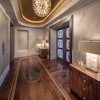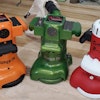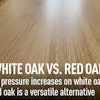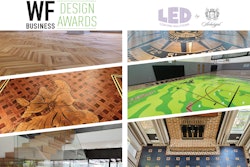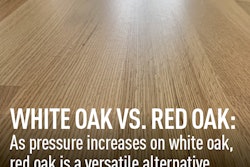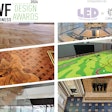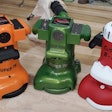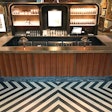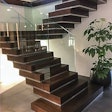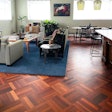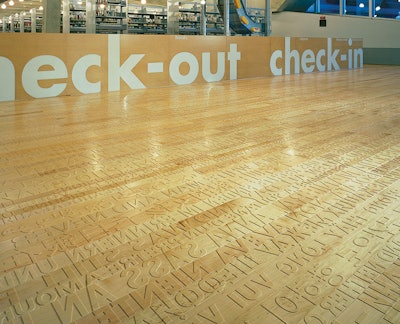
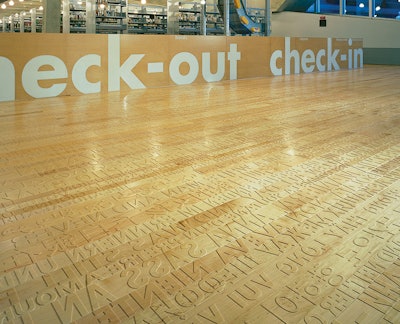 This maple floor designed by artist Ann Hamilton rests in the Evelyn W. Foster Learning Center at the Seattle Central Library.
This maple floor designed by artist Ann Hamilton rests in the Evelyn W. Foster Learning Center at the Seattle Central Library.
Wood floor people are generally the only adults who actually crawl on a wood floor, brushing away dust, checking for flatness or admiring good hand-scraping. For them, wood floors are tactile, not just something to walk on. But the Seattle Central Library in downtown Seattle is one place where you might find people of all types—children, adults, craftsmen, accountants—bending down to give a closer inspection to a certain wood floor. There, artist Ann Hamilton oversaw the installation of an intriguing 7,200-square-foot wood floor in the Evelyn W. Foster Learning Center. The center is just one part of the massive library, a 406,000-square-foot polyhedral LEED-silver building that was co-designed by world-renowned Dutch architect Rem Koolhaas and Seattle-ite Joshua Ramus. The flooring installation serves as floor covering and document to the history of the printed word, and with about 3,700 daily visitors entering the library through the center, it is also the threshold to the library's many mysteries.
Hamilton, an Ohio native, is a conceptual artist; she creates art that people can experience with multiple senses, and in this instance, her medium is a flooring surface. She received this commission through the Seattle Arts Commission, which organized all of the public art in the multi-million-dollar library. The random-length clear maple flooring specified for this art installation bears first sentences—which Hamilton likens to the threshold of a book—from an assortment of texts in 11 languages: Arabic, Chinese, English, French, German, Italian, Japanese, Korean, Russian, Spanish and Vietnamese; the "white space" around each character was routed out to a depth of 132 inch. What makes the flooring particularly engaging is that Hamilton inverted both the characters and sentences, serving two functions: First, the floor references the history of book printing and moveable type. Second, with the backward sentences shown in relief, Hamilton provides a surface that invites people to crouch down in order to investigate and touch. "It refers to the history of print production, and it's tactile underfoot," Hamilton says. The idea of creating a similar floor using metal was floated during the project's early stages, but Hamilton instead chose wood, a more significant material in the history of printing.
 The Seattle Central Library, a polyhedral building of glass and crosshatched steel, was designed by world-renowned Dutch architect Rem Koolhaas.
The Seattle Central Library, a polyhedral building of glass and crosshatched steel, was designed by world-renowned Dutch architect Rem Koolhaas.
Hamilton's art is usually large-comprising a spiraling tower or a vacant warehouse, in past instances-so she works with other people to complete her work, which has been displayed throughout the U.S. and Europe. Major contributors for this library project included Shawn Bourk and Mike Neidig, owners of Columbus, Ohio-based Color Text, a custom sign and graphic design firm. In the early stages of this project, after Hamilton's conception was complete, Color Text created several prototypes. First, the proper routing depth had to be determined: too deep and the floor would become a 7,200-square-foot trip hazard, too shallow and the floor's tactility would decrease while it would also wear down faster.
Color Text had to test its computer software that would assist in routing the material. After Hamilton's studio provided a digitized rendering of the floor layout, Color Text translated that information so its routers could interpret the characters' vectors. With a precise outline of every character in the floor, characters could easily span two boards if need be. "There was a whole series of logistics that we had to resolve prior to getting into the main production of what was a pretty massive project for us," Bourk says. To source the flooring material, Color Text worked with Panel Center, which procured ¾-inch clear maple tongue-and-groove flooring from Sheoga Hardwood Flooring & Paneling Inc.; the random-length flooring came in widths of 2¼, 3¼, 4¼, and 5¼ inches.
 'White space' on the random-length boards was routed to a depth of 1/32 inch, resulting in a varied and textured surface.
'White space' on the random-length boards was routed to a depth of 1/32 inch, resulting in a varied and textured surface.
Next, Color Text fabricated the textured flooring, fully realizing the importance of the boards' sequence. "We knew this material was going to be shipped to Seattle," Bourk says, "and that a whole other team was going to install it, so we were very meticulous in logging and wrapping these pieces. This way, when the installers got it, it wasn't like assembling a big puzzle." Color Text fabricated one row at a time and assigned each board a unique code denoting its position within that row. Each row was then bundled and shipped to a local woodworker, Dustin Icenhour with American Elegance Wood Floors, for hand-sanding and spray-finishing eight coats of Swedish finish made by Glitsa, a division of Rudd Co. After completing his work, Icenhour shipped the material back to Color Text, which then shipped the material-prefinished, sequenced and sealed-to Seattle for installation.
For Hamilton, the tactility of the floor's inverted characters also pays homage to the mystery of reading and learning. Characters are just abstract symbols when we first learn to read, she says, but over time the symbols are given meaning and we're able to assemble words and then complete ideas, which help us all learn and grow. "What happens when you read?" she poses. "These little marks on a piece of paper can forever change you, how you feel or what you think about something." Hamilton is keenly aware of the digital revolution around us, but to her the act of reading is not changing. "Whether it's digital or it's analog, there's a mystery of what happens [in our brain] with language . . . Think of how much time we spend in words-we're reading all of the time, and we're surrounded by print culture."
 Installers from Seattle's Rubenstein's began at one end of the building and straight-laid the entire floor.
Installers from Seattle's Rubenstein's began at one end of the building and straight-laid the entire floor.
Once the floor reached Seattle, installers from commercial flooring firm Rubenstein's went to work. First, a sleeper system of two-by-fours was laid down. S. Paul Singh, a senior project manager for Rubenstein's, says his team then used shims to create a level subfloor, on top of which was fastened two layers of plywood. Singh and his team also took into account the floor-mounted electrical outlets, making sure their subfloor height would place the tops of the outlets flush with the tops of the flooring boards. Next, all of the flooring material was brought on-site and allowed to acclimate for 10 days. Then Singh's team looked at the sequence code on each tongue-and-groove board and placed it in its correct spot, row by row, fastening it to the subfloor with adhesive and nails. "There would be stacks of book shelves," Singh explains, "plus it was going to be a children's area, with a lot of running around. We wanted to make sure the material was nice and tight, that there was no movement in it."
Even though all of the flooring boards were prefinished back in Ohio, the scope of the installation mandated some boards receive small touchups before being installed, sometimes with just a Q-Tip. "You're going to have a few nicks and dings, which is just a matter of detailing that out," Singh says. A board at the end of a row also required fine-tuning with a small sanding and finish reapplication. Because this project was-quite literally-a work of art, Singh says his workers were required to slow down from their typical installation speed. "Our guys were almost working like watchmakers, I mean, this was not an installation that you could slam-bam," he says. "We knew going into the project that this was not your usual installation."
 At just a few years old, this floor bears the patina of a highly textured floor.
At just a few years old, this floor bears the patina of a highly textured floor.
Color Text's Bourk says the installation went off without a hitch. "They were presented with a very organized project," he says. "There was not one issue. They never called us with re-cuts or anything. It all went as we thought it would."
Inspired thinking like Hamilton's, detailed planning like Bourk's, and great execution like that of Rubenstein's contributed to making the Seattle Central Library a landmark in architecture. The glass-and-crosshatched-steel building occupies an entire city block of downtown Seattle. Inevitably, a building this big, bold and expensive-$107 million-will draw attention, and one might assume Hamilton's work was, ultimately, some small part of Koolhaas' grand vision. But it wasn't. "I didn't focus on how this floor would fit in with that particular building," Hamilton says. "Instead, I focused on how this kind of floor fits in with the idea of the library as an institution."
She sees that libraries-along with the media-drenched world surrounding them-are changing. The world is only getting faster as computer screens of various sizes dictate more of our home and business lives. But there is no way to judge whether we're going forward without a reminder of where we've been, and the wood floor in the Evelyn W. Foster Learning Center at the Seattle Central Library—a pinnacle of modern design-documents a simpler time, when ideas had to be shared by first using wood blocks to print them on paper.
Project DetailsArtist: Ann Hamilton Studio (Columbus, Ohio) |












